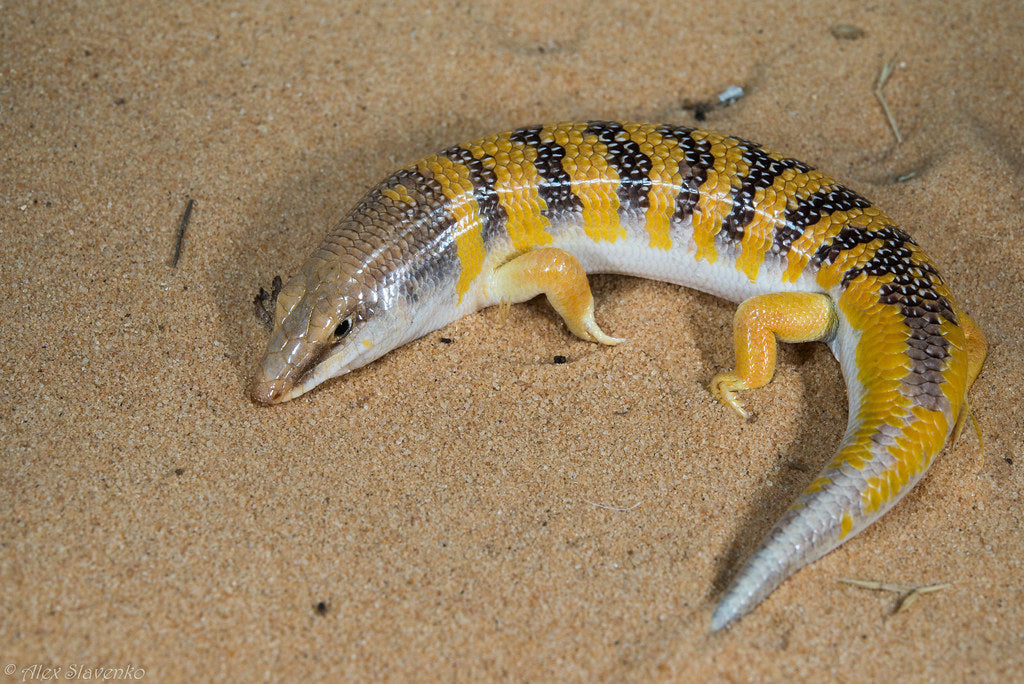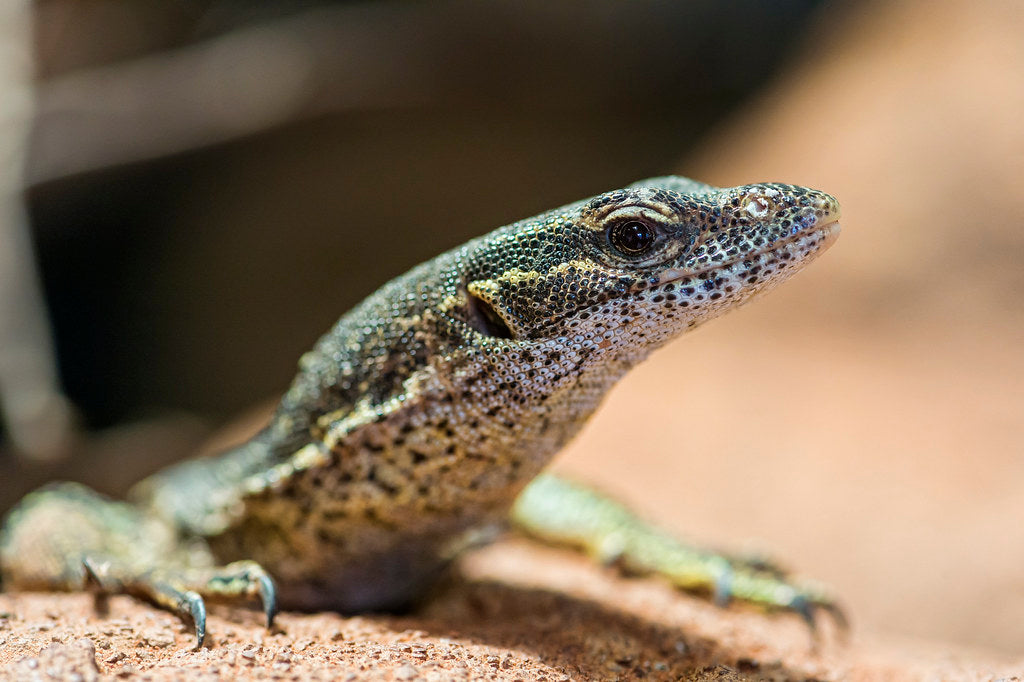Sandfish skinks (Scincus scincus) are small, diurnal, fossorial lizards primarily native to the sandy deserts of northern African and the Arabian peninsula. Their habitat features arid conditions, sand dunes, and sparse vegetation.
Sandfish skinks are generally 6-8” long, with a streamlined head, countersunk jaw, small black eyes, short limbs, a robust body, and a short tail. Their toes feature feather-like, flattened scales that allow them to “swim” through sand — thus their common name. Coloring and pattern varies by subspecies.
Sandfish skinks are fairly hardy, but are not commonly captive-bred, which means they are often in poor health when purchased. This makes them intermediate-level pets. With good care, they can live up to 10 years.
How much space do sandfish skinks need?
A single sandfish should be housed in no smaller than a 20 gallon (30” x 12” x 12”) terrarium. Of course, larger is likely to be used if provided, and highly recommended as one way to increase your pet’s quality of life in captivity.
Cohabitation (keeping multiple sandfish in the same terrarium) is not recommended.
Do sandfish skinks need UVB?
Sandfish are diurnal, which means that they are most active during the day. This means that high-quality UVB lighting is a requirement for keeping them healthy in captivity. Aside from helping provide a day/night cycle, UVB is also good for your skink’s overall wellbeing.
The best UVB bulbs for sandfish skinks are:
- Arcadia ShadeDweller kit
- Zoo Med T5 HO Reptisun 5.0
The UVB bulb should be roughly half the length of the enclosure and housed in an Arcadia or Vivarium Electronics fixture with a reflector. Place the fixture on the basking side along with the heat lamp. If the lamp is placed over mesh, then it should be 8-10” above the basking surface. If not obstructed by mesh, then it should be 10-14” above the basking surface.
UVB is blocked by glass and plastic, so you can’t give your skink UVB by placing its terrarium in front of an open window. This can also make your enclosure dangerously hot by creating a greenhouse effect! Also make sure that the fixture your UVB bulb is in does not have a clear plastic or glass bulb cover.
Lights should be on for 11 hours/day during winter, and 13 hours/day during summer to simulate seasonal changes in day length.
What basking temperatures do sandfish skinks need?
Sandfish should have a basking surface temperature of 130-140°F, as measured by an infrared temperature gun pointed at the sand directly under the heat lamp. There should also be a cooler area on the opposite side of the enclosure that stays between 80-90°F.
It’s best practice to provide heat for your skink with a halogen heat lamp. This should be housed in a ceramic-socket dome fixture and placed on one side of the enclosure, next to the UVB lamp. If it's too warm, try a plug-in lamp dimmer — the air of the basking area should not get above 100°F. If it's too cool, you need a higher-wattage bulb. Do not use ceramic heat emitters (CHEs), red bulbs, or blue bulbs, as these are not as effective.
Heat sources should be turned off at night.
What humidity levels do sandfish skinks need?
Sandfish skinks need a low-humidity environment with access to a humid microclimate for best health. Average ambient humidity should be below 50%, as measured by a digital probe hygrometer with the probe in the middle of the terrarium.
However, you will need to provide a humid hangout area on one side of the enclosure for the skink to use. The easiest way to do this is by wetting down the sand on part of the cool side of the enclosure, preferably under a flat, thin rock or similar to help trap the moisture.
What substrate is good for sandfish skinks?
Substrate covers the floor of your skink’s terrarium and helps make the enclosure more attractive, but it also cushions your skink’s body and provides something for them to dig in. It’s ideal to use a substrate that imitates the “substrate” that the reptile naturally lives on in the wild. For sandfish skinks, that means it should be fine dune sand.
We recommend the following substrates for sandfish skinks:
- Zoo Med ReptiSand
- Exo Terra Desert Sand
Substrate should be at least 4” deep and completely replaced every 3-4 months. Remove poop and urates daily, along with contaminated substrate.
What décor can you use in a sandfish skink terrarium?
Sandfish spend most of their time underground, but that doesn’t mean the enclosure should be barren. It’s terribly boring (and stressful!) for a lizard to be stuck in an enclosure with nothing in it except substrate and a water bowl to interact with. So vary the landscape a bit!
Here are some ideas:
It’s best practice to cover three sides of the enclosure to help the skink feel more secure in its environment!
What do sandfish skinks eat?
Sandfish skinks are primarily insectivorous, which means that they need to eat insects (live) in order to get the nutrition that their bodies need.
How often and how much they need to eat depends on age:
- Hatchlings (under 3” long) — 2x daily
- Juveniles (3-5” long) — daily
- Adults (at least 5” long) — every other day
Offer as many insects as they can eat in a 5-minute period.
Feeder insects for sandfish skinks: dubias, discoids, red runners, crickets, black soldier fly larvae, mealworms, darkling beetles
Supplements
You will need calcium and vitamin supplements to help prevent your lizard from developing a deficiency. We recommend Repashy Calcium Plus LoD, lightly dusted on all of your lizard’s feeder insects. It’s okay to skip a dusting every once in a while.
Water
Provide a small water bowl where your lizard can always get a drink when needed. Change the water daily and scrub the bowl with a reptile-safe disinfectant weekly, or whenever it becomes soiled.
Do sandfish skinks like to be handled?
Few reptiles actually “like” to be held, and sandfish definitely prefer to be left alone. Fortunately, it’s really fun to watch your sandfish hunt for insects when you drop them one at a time on top of the sand!
This care sheet contains only very basic information. Although it’s a good introduction, please do further research with high-quality sources to obtain additional information on caring for this species. Here are some great sources to get you going in the right direction:
"Scincus scincus" by alexslavenko is licensed under CC BY-NC-SA 2.0




Leave a comment
This site is protected by hCaptcha and the hCaptcha Privacy Policy and Terms of Service apply.